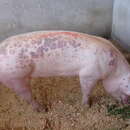pms
nòm ant ël fil


Erysipelothrix is a genus of bacteria containing four described species, Erysipelothrix rhusiopathiae, Erysipelothrix tonsillarum, Erysipelothrix inopinata and Erysipelothrix larvae.[1][2][3][4] Additional species have been proposed based on DNA-DNA hybridization studies[5][6] "The hallmark of Erysipelothrix is the presence of a type B cell wall, in which the peptide bridge is formed between amino acids at positions 2 and 4 of adjacent peptide side-chains and not, as in the vast majority of bacteria, between amino acids at positions 3 and 4."[3]
The best known species within the genus is Erysipelothrix rhusiopathiae, which is the cause of erysipelas of domestic pigs, poultry and other animal species. In humans, E. rhusiopathiae infections are termed erysipeloid. Erysipelothrix tonsillarum has been described as a pathogen for dogs and has been isolated from the tonsils of healthy pigs and cattle.[7] Disease caused by E. inopinata or E. larvae have not been described.
Bacteria of genus Erysipelothrix are straight, or slightly curved, slender, nonmotile rods which may exist singly, in V-shaped pairs, or in short chains. Some strains have a tendency to form long filaments. The bacteria are Gram-positive but can be mistaken for Gram-negative bacteria during analysis because they lose their staining easily. They are aerobic to facultatively anaerobic but not acid-fast.[8]
The currently accepted taxonomy is based on the List of Prokaryotic names with Standing in Nomenclature (LPSN)[1] and National Center for Biotechnology Information (NCBI)[9]
Erysipelothrix is a genus of bacteria containing four described species, Erysipelothrix rhusiopathiae, Erysipelothrix tonsillarum, Erysipelothrix inopinata and Erysipelothrix larvae. Additional species have been proposed based on DNA-DNA hybridization studies "The hallmark of Erysipelothrix is the presence of a type B cell wall, in which the peptide bridge is formed between amino acids at positions 2 and 4 of adjacent peptide side-chains and not, as in the vast majority of bacteria, between amino acids at positions 3 and 4."
The best known species within the genus is Erysipelothrix rhusiopathiae, which is the cause of erysipelas of domestic pigs, poultry and other animal species. In humans, E. rhusiopathiae infections are termed erysipeloid. Erysipelothrix tonsillarum has been described as a pathogen for dogs and has been isolated from the tonsils of healthy pigs and cattle. Disease caused by E. inopinata or E. larvae have not been described.
Bacteria of genus Erysipelothrix are straight, or slightly curved, slender, nonmotile rods which may exist singly, in V-shaped pairs, or in short chains. Some strains have a tendency to form long filaments. The bacteria are Gram-positive but can be mistaken for Gram-negative bacteria during analysis because they lose their staining easily. They are aerobic to facultatively anaerobic but not acid-fast.
Erysipelothrix é un xénero de bacterias que contén tres especies.[1] A característica distintiva de Erysipelothrix é a presenza dunha parede celular grampositiva de tipo B, na cal a ponte peptídica do peptidoglicano fórmase entre aminoácidos situados nas posicións 2 e 4 de cadeas peptídicas adxacentes, en lugar do que ocorre na maioría das bacterias, que o forman entre aminoácidos nas posicións 3 e 4."[1]
A especie mellor coñecida é Erysipelothrix rhusiopathiae, que causa erisipelas en porcos e outras doenzas en animais. As outras dúas especies aparentemente non son patóxenas.[1] [2] e Erysipelothrix inopinata describiuse en 2004. Estas dúas últimas especies foron illadas de tonsilas de porcos sans.[1] Estableceuse a nova familia Erysipelotrichidae para clasificar nela este xénero.[1]
Estas bacterias son grampositivas. Porén, poden confundirse con bacterias gramnegativas durante as análises porque perden facilmente a súa tinguidura de Cristal violeta. Non son ácido-alcohol resistentes. Son bacilos finos, inmóbiles. Son rectos ou lixeiramente curvados e poden aparecer longos e filamentosos. As célula aparecen soas, en pares con forma de V, ou formando curtas cadeas. Son aeróbicas ou anaerobias facultativas.[3]
Erysipelothrix é un xénero de bacterias que contén tres especies. A característica distintiva de Erysipelothrix é a presenza dunha parede celular grampositiva de tipo B, na cal a ponte peptídica do peptidoglicano fórmase entre aminoácidos situados nas posicións 2 e 4 de cadeas peptídicas adxacentes, en lugar do que ocorre na maioría das bacterias, que o forman entre aminoácidos nas posicións 3 e 4."
A especie mellor coñecida é Erysipelothrix rhusiopathiae, que causa erisipelas en porcos e outras doenzas en animais. As outras dúas especies aparentemente non son patóxenas. e Erysipelothrix inopinata describiuse en 2004. Estas dúas últimas especies foron illadas de tonsilas de porcos sans. Estableceuse a nova familia Erysipelotrichidae para clasificar nela este xénero.
Estas bacterias son grampositivas. Porén, poden confundirse con bacterias gramnegativas durante as análises porque perden facilmente a súa tinguidura de Cristal violeta. Non son ácido-alcohol resistentes. Son bacilos finos, inmóbiles. Son rectos ou lixeiramente curvados e poden aparecer longos e filamentosos. As célula aparecen soas, en pares con forma de V, ou formando curtas cadeas. Son aeróbicas ou anaerobias facultativas.
Erysipelothrix é um gênero de bactérias bacilares longas, finas e gram-positivas, mas que se tingem mal, mesmo sem ter ácido-álcool resistência. São aeróbicas ou facultativamente anaeróbicas e imóveis. [1]
Contêm três espécies, sendo a Erysipelothrix rhusiopathiae a mais famosa por causar erisipela em suínos, pavões e outros animais e em humanos causa erisipelóide de Rosenbach. As outras duas espécies: Erysipelothrix tonsillarum descrita em 1987 e Erysipelothrix inopinata descrita em 2004 aparentemente não causam doenças. Essas duas espécies foram isoladas a partir de amígdalas de suínos saudáveis. A nova família foi Erysipelotrichidae criada para conter este gênero.[2]
A marca de Erysipelothrix é a presença de uma parede celular do tipo B, em que a ponte é formada entre os aminoácidos nas posições 2 e 4 dos peptídios de cadeias laterais adjacentes e não adjacentes, enquanto na grande maioria das bactérias essa ponte é entre os aminoácidos nas posições 3 e 4.
Erysipelothrix é um gênero de bactérias bacilares longas, finas e gram-positivas, mas que se tingem mal, mesmo sem ter ácido-álcool resistência. São aeróbicas ou facultativamente anaeróbicas e imóveis.